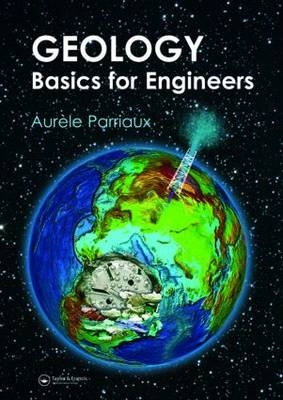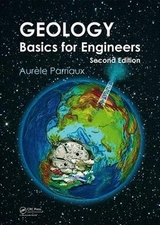
Geology
Taylor & Francis Ltd (Verlag)
978-0-415-46165-8 (ISBN)
- Titel erscheint in neuer Auflage
- Artikel merken
Geology – Basics for Engineers presents the physical and chemical characteristics of the Earth, the nature and the properties of rocks and unconsolidated deposits/sediments, the action of water, how the earth is transformed by various phenomena at different scales of time and space. The book shows the engineer how to take geological conditions into account in his projects, and how to exploit a wide range of natural resources in an intelligent way, reduce geological hazards, and manage subsurface pollution.
Through a problem-based-learning approach, this instructional text imparts knowledge and practical experience to engineering students (undergraduate and graduate level), as well as to experts in the fields of civil engineering, environmental engineering, earth sciences, architecture, land and urban planning.
The DVD that supplements the book contains solutions to the problems and animations that show additional facets of the living Earth.
*The original French edition of the book (2007) won the prestigious Roberval Prize, an international contest organized by the University of Technology of Compiegne in collaboration with the General Council of Oise, France. Geology, Basics for Engineers, was selected out of a total of 110 candidates.The jury praised the book as a “very well conceived teaching textbook” and underscored its highly didactic nature, as well as the excellent quality of its illustrations.
About the author Aurèle Parriaux studied geology at the Swiss Federal Institute of Technology (EPFL) in Lausanne, Switzerland. He obtained his Ph.D. in hydrogeology and followed several postgraduate courses in hydrogeology, operational hydrology and geotechnics. In 1991, he was appointed Professor of Engineering Geology at EPFL and presently he is head of the Engineering and Environmental Geology Laboratory (GEOLEP) at the same institute. He leads a research team of about twenty people specializing in the fields of geological hazards and underground resources. Professor Parriaux has significant teaching responsibilities. He teaches geology to students in 'Civil Engineering' and 'Environmental Sciences and Engineering'. Moreover, he teaches "Engineering Geology" at the Universities of Lausanne and Geneva. Parallel to his research and teaching, Aurèle Parriaux carries out expert appraisals in various fields of engineering and environmental geology. In particular, the recent appraisal of the compatibility between construction of tunnels and protection of groundwater resources. Since the creation of the new School of Architecture, Civil and Environmental Engineering (ENAC) at the Swiss Federal Institute of Technology in Lausanne, he participates in the teaching related to territory and landscape into which he brings the geological and geomorphologic component. Aurèle Parriaux is active in several international organizations. He was chairman of the Swiss Hydrogeological Society for six years. From 2001 to 2006 he was Director of the Civil Engineering Section of the Swiss Federal Institute of Technology of Lausanne. In 2006, he published his book "Géologie: bases pour l'ingénieur". The second edition of this successful textbook will be published in 2009. In competition with 105 scientific books, "Géologie : bases pour l'ingénieur" received the Roberval Prize in 2007. The publisher CRC Press/Balkema, member of the Taylor & Francis Group decided to publish an English translation of the book (Geology: basics for Engineers, 2009). In December 2008, Prof. Parriaux was nominated Chevalier of the Order of Academic Palms by the Prime Minister of the Republic of France.
1. The Geology-Engineering Partnership
Areas of engineering geology
Project construction
Natural hazards
Geological resources
Environmental pollution
The history of geology
2. The Earth in Space
The solar system
Historical representations
General structure
The Earth’s revolution
The telluric planets
Atmospheres and hydrospheres
Geology and geologic activity
Giant planets
Comets
Meteorites
Stony meteorites
Metallic meteorites
3. The Earth in Time
Measurement of geologic time
Radiometric methods
Stratigraphic methods
Paleontological methods
Summary of dating methods
Origin of the Universe and matter
Initial nucleosynthesis
Stellar phase
Accretion of the planets
Voyage through time: From the Precambrian to the
Quaternary
Precambrian Era
Primary Era (Paleozoic)
Secondary Era (Mesozoic)
Tertiary Era (Cenozoic)
Quaternary Era (Anthropozoic)
4. Physics of the Globe
Seismology
Rupture mechanisms
Types of seismic waves
Laws of wave propagation
Causes of earthquakes
Monitoring and treatment of seismic signals
Seismic risk
Seismic prospecting
Gravimetry
Connection with mechanics
Notion of a geoid
Measurement of the gravitational fi eld and its
treatment
Interpretation of anomalies
Principles of isostasy
Density of Earth’s rocks
Magnetism
Causes of the Earth’s magnetic fi eld
Components of the magnetic fi eld at a point
on the Earth’s surface
Measurement of the magnetic fi eld
Paleomagnetism
Geothermics
Thermal transfer within the Earth
Exploitation of geothermal energy
5. Rock Forming Minerals
Crystallography
Internal structure of minerals
Crystal morphology
Cohesion properties
Optical properties of minerals
Geochemistry
Silicates
Carbonates
Sulfates
Phosphates
Halides
Sulfi des
Oxides and hydroxides
Practical mineral identifi cation
6. Magmatism and Magmatic Rocks
Composition of the Earth’s layers
Magmatism and plate tectonics
The history of plate tectonics
Paleomagnetic reconstruction
Possible relationships between plates
From magma to magmatic rocks
Process of magma generation
Magma solidifi cation processes
Magmatic confi gurations
Magmatic events
Plutonism and plutonic rocks
Volcanism and volcanic rocks
Major magmatic rocks
Classifi cation
Field identifi cation methods
7. The Water Cycle
Water reserves and their exchanges
The atmosphere
Atmospheric reservoir
The greenhouse effect
Atmospheric precipitation
Rainfall fractionation on the soil
Surface water
Rivers and streams
Lakes
Glaciers
Groundwater
Porosity of geological materials
Water fl ow in geologic media
Basics of hydrodynamics
Application of permeability to the subsurface
Hydrodynamic application of fl ow toward a well
Hydrologic balance of aquifers
Groundwater intake
Effects of drainage and irrigation
Groundwater management
Groundwater protection
Groundwater and civil engineering projects
Water in the seas and oceans
8. The Continental Sedimentary Environment
Generalities
Continental erosion
Continental sedimentation
The slope environments
Particle transport on slopes
Mass transport
The alluvial environment
Solid transport in rivers
Areas of stream and river erosion
Alluvial zones
The lacustrine environment
Deltas
Lacustrine basins
The palustrine environment
Swamps at the bottom of depressions
Swamps created by springs
Marsh drainage
Exploitation of peat
Boreal and polar environments
Glacial regions
Non-glaciated regions
The desert environment
Eolian erosion and transport close to the soil
Transport of suspended particles
Water in deserts
Protective measures
9. The Oceanic Sedimentary Environment
Continental margin
Detrital sedimentation
Biogenic sedimentation
Evaporite deposits
The continental rise and the abyssal plains
Detrital sedimentation
Biogenic sedimentation
Hydrochemical sedimentation
10. Diagenesis and Properties of Sedimentary Rocks
Diagenetic processes
Compaction
Cementation
Mineralogical modifi cations
Detrital rocks
Conglomerates
Sandstones
Siltstone
Claystones
Biogenic rocks
Carbonate rocks
Siliceous rocks
Fossil fuels
Evaporite rocks
Primary dolomite
Gypsum and anhydrite
Halite rocks
Potassium rocks
Cargneules
11. Metamorphism
Transformation processes
Mineralogical modifi cations
Chemical modifi cations
Mechanical modifi cations
Types of metamorphism
Regional metamorphism
Contact metamorphism
Cataclastic metamorphism
Principal metamorphic rocks and their properties
Pelitic sequence
Quartzo-feldspathic sequence
Carbonate sequence
Calcareous-pelitic sequence
Mafi c sequence
Ultramafi c sequence
Identifi cation of magmatic, sedimentary and metamorphic rocks
12. Tectonics
Mechanical stresses in the subsurface
Physical defi nition
Stress state in geological environments
Stress-deformation relationships
Laboratory tests
Rock deformation observed in the fi eld
Brittle deformation
Joints
Faults
Thrusting
Characterization of discontinuities in a rock massif
Ductile deformation
Folds
Concentric folds
Similar folds
Fold nappes
Geometric representation and treatment of structural elements
Mapping of structural elements
Geometric tools
Stereographic projections
The Alps: a tectonic model
Jura
Molasse plateau
Prealps
High Calcareous Alps
External crystalline massifs
Internal thrust nappes
Present-day deformation
13. Weathering
Weathering processes
Thermal processes
Physicochemical processes
Catalog of weathering-prone materials
Extent of weathering at depth
Engineering concerns
Weathering effects on mechanical properties
Weathering effects on hydrogeological properties
Screening for weathering
14. Geology’s Role in the Major Issues Facing Society
Land development and natural resources
Food resources
Energy resources
Underground resources
Mineral resources
Geomaterials resources
Resources of the Space
Environmental protection
Ecosystems and biodiversity
Natural hazards
Climate change
Geologic waste disposal
Subsurface pollution
Conclusion
BIBLIOGRAPHY
INDEX
| Erscheint lt. Verlag | 13.8.2009 |
|---|---|
| Verlagsort | London |
| Sprache | englisch |
| Maße | 174 x 246 mm |
| Gewicht | 1361 g |
| Themenwelt | Naturwissenschaften ► Geowissenschaften ► Geologie |
| ISBN-10 | 0-415-46165-0 / 0415461650 |
| ISBN-13 | 978-0-415-46165-8 / 9780415461658 |
| Zustand | Neuware |
| Haben Sie eine Frage zum Produkt? |
aus dem Bereich



